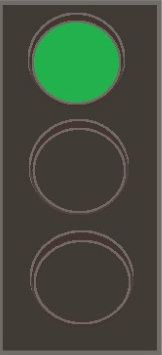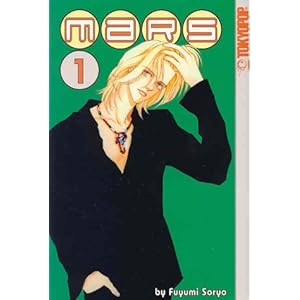MARS (Masu), by Fuyumi Soryo. First published in 1996, and first published in North America in 2002.
PLOT: Kira is the 'weird girl' of her class. You know the type - quiet, distant, spending most of her free time doodling. Her world is turned upside-down when a handsome boy named Rei asks her for directions. She gives him a map, and inadvertantly gives him an exquisite Klimt-inspired sketch of a mother and child. He is stunned by the beauty of her artwork and tries his best to better know the artist behind it. Bit by bit, Kira finds herself more and more drawn toward Rei, the motorcycle racing class rebel who is also outgoing, brave, and more than a little bit morbid. Rei earns Kira's trust after taking down a teacher who was harassing Kira, but now he may not be able to save her from the wrath of their fellow students, particularly those who envy Kira's hold over Rei.
STORY: Now this is a high school shoujo romance I can get behind! This is the kind of story I've been dying to find in this vast and mostly unspired subgenre. Why? Allow me to explain.
First and foremost, both the heroine and the love interest are well-developed, even at this early stage. Many shoujo heroines are said to be wallflowers, but Kira truly fits the role and it shows in a lot of non-verbal cues. It's not just that she doesn't talk to a lot of people, she actively shields herself from touching and being touched by others and covers herself in long sleeves and skirts. Soryu is clearly a writer who remembers the 'show, don't tell' rule, and Kira doesn't need to say a word (or have others provide exposition through gossip) to tell us that she is emotionally hurting.
Mind you, Rei's not that much more well-adjusted himself. Indeed, he's a big grab-bag of conflicting emotions and issues. On the surface he's a snarky slacker whose good looks and charms make him very popular with the ladies (to the point where he's a bit of a man-slut). Yet already we get glimpses of another Rei, one who escapes from as yet unspecified family issues through the thrill of racing and speaks of death and other similiar things as if he were discussing the weather, and the one who manages to find a way to bring Kira out of her self-imposed shell. Again, all of this is shown to us not through narration or third-party exposition, but through his own words and deeds. The fact that I can say so much about these two just from the first volume is testament enough to Soryo's skillful writing.
She's also very good at writing realistic romance. There are no wacky meet-cutes to be found here or strange set-ups to bring two dissimilar people together. No, it's just a guy getting to know and love a girl through - *GASP* - DIRECTLY TALKING TO HER IN A CASUAL, FRIENDLY MANNER. It's so refreshing to find a shoujo series where the main couple don't fight as a cover for their true feelings or can barely speak two words to one another without blushing, leaving every enigmatic phrase or action open to doubt and misinterpretation. Kira and Rei actually get to know one other as friends, discussing their interests, lives, and feelings. They build trust in one another through action and deed, and it becomes apparent that they both bring out better qualities in one another. Plus, they don't lose their own sense of individuality through the relationship. They still have their own lives, be it Kira with her art and her best friend, Tatsuya, and Rei has his racing and his friends and mentors from that circuit. This may be the most practical, well-adjusted, and realistic romance I've ever seen in a manga, shoujo or otherwise.
Of course, it can't all be about two kids falling in love. There does have to be some drama to help move things along, and sadly this is w.here Soryo stumbles. I really feel that the near-molestation of Kira was not necessary. Sure, the resolution to that plot thread is kind of epic and it did serve as proof of how Rei wants to protect Kira, but it felt a touch too melodramatic for the rest of the story and even a bit exploitative. The way that Kira is then bullied by her classmates is slightly more realistic, but only slightly. Now it's true that hell hath no fury like a pissed-off high school girl, and it's equally true that girls can bully other girls for truly petty reasons, but again its addition just feels somewhat off. It's like Soryo is trying to force the drama and conflict into the story versus letting it develop naturally.
While Mars does sometimes indulge in melodrama for the sake of moving the plot along, the characters and relationship are written so well that it more than makes up for any plot-related missteps.
ART: Soryo artistry is also a step above many shoujo mangaka. Soryo is noted for having attended a fashion school, but she clearly paid attention in her art and live study classes, because there's a real sense of life and character in the way she draws her cast, be it subtle changes of posture, the expressiveness and beauty of their faces, and all the little details she adds. The linework is notably fine, particuarly in the faces and hair. Soryo finds that perfect balance between drawing characters that move and look like real people but still making them stylized and appealing in a manner unique to her.
She's also rather free and easy with the layout of her pages, stacking images over images both inside and outside of the panels. At times it verges on busy looking, since there's also often a lot of conversation going on (this is a very talkative manga), but the fineness of her linework helps to keep it from the point where it becomes a distraction from the art. I also like that she's very conservative with her use of screentone and effects. Too many shoujo artist abuse those either as a way of filling space or telegraphing emotion, but Soryo prefers to let her story communicate the emotions, not the backgrounds. Really, that's a fine summary of her artstyle as a whole - it's the perfect compliment to her well-established characters. It's finely and skillfully rendered, bringing a whole new level of non-verbal communication to our leads' interactions and letting the emotion within them bloom forth naturally instead of visually forcing into our faces.
PRESENTATION: Sadly, there's nothing of note here - typical for a Tokyopop release.
RATING:
 High school romance is a concept that has been done to death in shoujo, but Mars is one of the best and most mature takes on the concept that I have come across, and even those who are weary of this subgenre should give this series a look.
High school romance is a concept that has been done to death in shoujo, but Mars is one of the best and most mature takes on the concept that I have come across, and even those who are weary of this subgenre should give this series a look.This series was published in the USA by Tokyopop. All 15 volumes were released, as well as the spinoff volume "A Horse By No Name," and all are currently out of print.
You can purchase this volume and many more like it through RightStuf.com!

No comments:
Post a Comment